In modern gardening, it is customary to use several types of beds. The purpose of their arrangement, on the one hand, is to create optimal conditions for plants, which means getting the most out of them. And on the other hand, a reduction in the amount of work, facilitating the work of a summer resident. The type of proper bed decides a lot when growing vegetables and herbs. Properly approaching its choice and arrangement, you can save soil moisture, increase the temperature of the soil, or, conversely, prevent it from overheating in the summer. Even with weeds it is easier to fight on properly equipped beds. Which garden bed to choose for your site? Our article will help you decide.
High raised beds
Unlike standard beds, which are on the same level with the garden, high bulk beds rise relative to the level of the soil. Due to this, they warm up faster. Therefore, high beds are effective in cool regions, especially for growing heat-loving crops.
It is good to build such beds in areas with a high level of groundwater, in low-lying and flood-prone areas. Any beds raised above the soil level are very good for growing crops that are sensitive to diseases o
The easiest way to arrange a high bed is bulk. It can be done using imported soil. To do this, it is enough to mark the bed with pegs and pour the earth. If the earth is dense, heavy, then first you need to arrange a drainage layer - put thick branches, rough stems, hemp. And then pour fertile soil. This method of arrangement requires material costs for the acquisition of soil.
The second method is more economically accessible, but more laborious. To equip the beds, it will be necessary to raise part of the soil from the paths to the garden. Thus, the bed will become higher. If the soil is heavy, then it is necessary to make a drainage layer. If possible, compost, turf turned down with grass, fallen leaves, plant debris can be laid in the bottom layer of the bed. Thus, it is possible to partially solve the problem of lack of soil.
Advantages of high bulk beds
Raised beds have a number of advantages over traditional ones:
- They warm up faster in the spring, which means that planting on such beds can be started earlier;
- During the season, the soil temperature in them is higher, so you can plant more heat-loving crops in the country;
- These beds are universal due to the fact that they settle down quickly enough, you can plant any crop on them. Perhaps only moisture-loving cabbage, which does not develop well in hot conditions, will not feel good on a high bed;
- In low-lying areas, in conditions of regular flooding, these beds will be ideal for growing plants. According to the principle of a high bed, a so-called “cushion” is laid for growing fruit trees in conditions of a high level of groundwater;
- High beds allow you to grow vegetables in areas with low fertility, however, for this you will have to spend money on purchased soil.
Cons of high bulk beds
High beds, in addition to advantages, have their drawbacks. In some cases, they are so significant that it is better to abandon the idea at the planning stage.
The biggest problem when arranging beds is where to get soil for them? Imported - expensive, if you use the land from the paths, then the beds will not come out very high.
Another disadvantage of such a bed is its overheating and drying of the soil in hot weather in summer. To avoid this, you do not need to make very high beds. Its optimal height is 20–30 cm. The issue of overheating and drying out of the soil can be solved with the help of mulching. Where to get mulch is a separate question.
On high beds without a border, during rain or irrigation, water rolls and the soil is washed away.
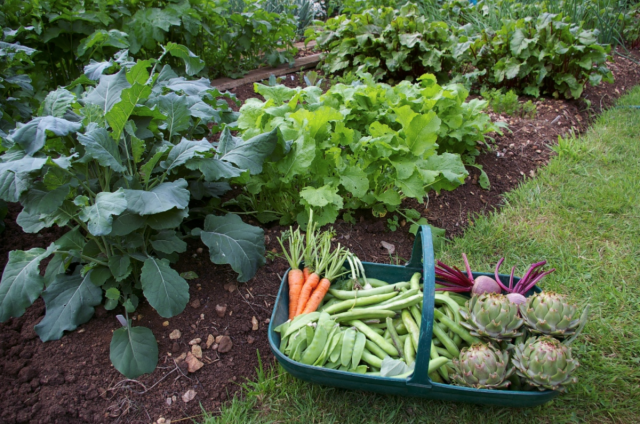
Raised beds-boxes
Many of these shortcomings are deprived of an improved variety of high beds - a bed-box. This is a high bed, fenced with some material.
The process of creating a bed-box is quite simple, the main thing is to stock up on the necessary materials. A box with a height of 15 to 70 cm is assembled at a place marked for a bed. Boards, logs, slate, and bricks can be used to make the box.
From mice, a fine mesh is placed at the bottom of the box. Then comes a layer of organic matter: branches, tops, foliage, humus. And a fertile layer of earth is poured on top - and the bed is ready.
Advantages of a high raised bed garden box
Beds-boxes in the spring are much better warmed up by the sun. This means that the planting season can start much earlier. In addition, it is easier to fix the arcs in them and pull the covering material.
In beds arranged with materials that do not warm up so much in the sun (wood, brick, slate), moisture is retained better, which means that it will be possible to water less often.
The "sides" of the beds protect the soil from erosion. The fence of the bed clearly limits it, so that perennial weeds cannot get into the bed.
High beds-boxes in the country are very convenient to use: to plant, weed, you need to bend over less than in a traditional garden bed. There is no need for digging, it is enough to loosen the earth.
Such beds, if they are made with high quality, are beautiful and tidy, so they are used in creating the so-called "beautiful garden".
From the bed-box, if desired, you can make a warm bed for growing very early greens or seedlings. To do this, the soil is removed from the box and organic matter is laid in layers.
Cons of a high bed-box
The main problem that stops summer residents is the need to purchase materials for arranging the garden. As well as the lack of opportunity and skills to build the basis of the structure.
Always keep in mind that in extreme heat, the beds can overheat. The way out is soil mulching and the right choice of material. According to experienced gardeners, plants feel best in beds equipped with wood.
In high beds, the soil can freeze through in winter, so they are more suitable for annual plants. Such a bed needs to be mulched for the winter and, if possible, throw snow. Even if there are no plants in it, beneficial microorganisms in the soil may die.
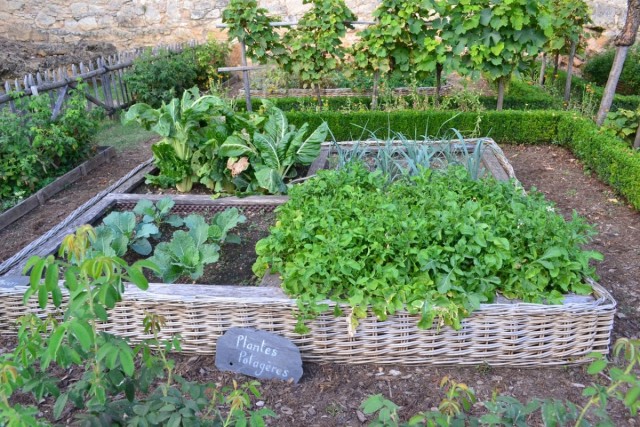
warm beds
Warm beds differ from ordinary ones in that they are based on organic materials, which, when decomposed, release a significant amount of heat. Therefore, warm beds, in the first place, are suitable for regions with a cold climate, late spring and short summer. In the middle lane, these beds are ideal for growing heat-loving crops, early greenery and even seedlings.
In addition to heat, as a result of biochemical processes, the nutrients necessary for plants are formed, which can be used to grow plants demanding fertility: cucumbers, zucchini, pumpkins, tomatoes, peppers. Particularly well in such beds is the cultivation of capricious eggplants.
The basic principle of creating a warm bed is that various types of organic materials are laid in layers. The bottom layer serves as drainage. This layer provides air access and removal of excess water, so hemp, thick tree branches, and rough plant stems are laid down. The higher, the less rough organics fit.
The second layer is usually plant and food waste, weeds, sawdust, wood chips. The next layer is compost, humus, animal waste - biofuel, which, decomposing, will be a source of heat. Next comes a layer of fertile soil. Each layer must be spilled with water and compacted.
If the garden bed is being prepared in the fall, then it is better to cover it with a film, covering material, in order to avoid getting weed seeds there.
In order for biochemical processes to proceed correctly, it is important to observe the following rules:
- do not lay plant residues with signs of disease;
- for proper air exchange, the drainage layer must be mandatory;
- the bed should be kept moist (but not damp).
Warm beds can be equipped both in spring and autumn. In the fall, it is more practical to do this: when the main work is done, you can take your time. There are many plant residues that are needed in large quantities. By spring, these beds will be ready for use.
There are several options for warm beds. Depending on the nuances of the arrangement, they are recessed, raised, or combined.
Buried warm beds
Under the buried bed, you will need to dig a trench, which then needs to be filled in layers with organic matter. As a result, the finished bed will be flush with the soil level. The peculiarity of using such a bed is that it will need to be watered less often, compared to a raised one. But it can not be equipped where water can stagnate.
Raised warm beds
Under the raised bed, you do not need to dig a trench, it is laid on the surface of the earth. Such a bed is the best option for cold, humid regions where there is a risk of flooding.
A hill bed is a variant of a raised bed without borders. Such a bed is very quickly and easily equipped.
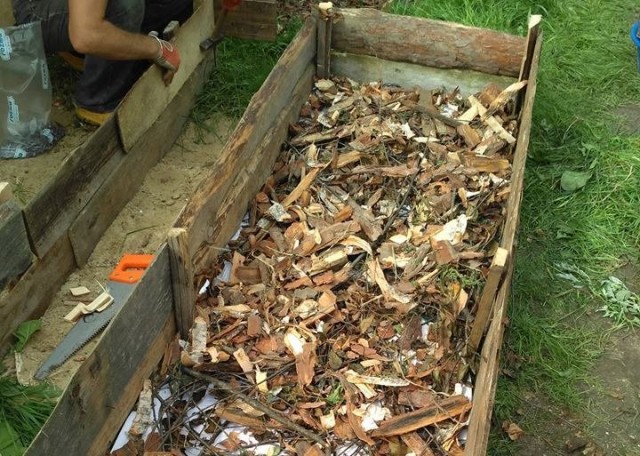
Combined warm beds
Settled in a trench, their upper part is above the ground. A trench under such a bed needs to be dug 2 times smaller than under a buried one.
Care of warm beds consists in timely watering, loosening and weeding. In a dry summer, in order to save raised warm beds from drying out, it is advisable to mulch them.
Benefits of warm beds
- The garden season on warm beds can start earlier than usual. And, at the same time, the cultivation of plants can be extended by 2-3 weeks;
- You can rationally use the beds due to the possibility of growing early greens or seedlings before planting the main crop. To do this, it is enough to put arcs with shelter. The result is a mini greenhouse.
- The earth does not need to be dug up, it is always loose due to the large amount of organic matter.
- On such beds, optimal conditions are created for heat-loving plants, which means that their productivity increases.
- At its core, a warm bed is a kind of compost heap in which there are nutrients necessary for plants. Therefore, fertilizing can be minimized.
- On poor, infertile soil, you can create beds with good quality soil.
- This option of arranging the beds allows you to effectively use plant residues without a compost heap, as well as dispose of animal waste.
Cons of warm beds
- The arrangement of a warm bed in the country requires considerable effort, and in the case of making beds with sides, material costs are also needed;
- Durability of use. The effect of a warm bed disappears after five years, when the process of decay of organic matter ends. In this case, it will be possible to make a bed in a new place. And if the bed is stationary, arranged in the form of a box, then it will be possible to remove the soil from it for use elsewhere, and equip the warm bed again, observing the same conditions.
- Mice are very fond of settling in warm beds, so before arranging the beds, you must definitely stock up on a grid with small cells and cover the base of the future bed with it.
Deep Raised Beds
Such beds are also called low or recessed. The name speaks for itself. The main function of the "low" beds is to save the soil from overheating and retain moisture. Therefore, they are suitable for regions with a hot, sultry climate, where droughts are very common, especially for areas with sandy or infertile soil that constantly dries up. The arrangement of such beds requires physical effort, so they are usually prepared in the fall, when the heat subsides.
The choice of location must be approached responsibly, even in the most arid region natural disasters can occur periodically. Therefore, a bed should not be arranged in low-lying places of the site, where there may sometimes be an excess of water.
For the arrangement, it is necessary to dig a trench of the required length in the selected area. The width of such a bed will depend on whether the walls of the bed will be laid out. If there are walls, then the thickness of the material must be added to the desired width of the beds.
Brick, stone, cinder blocks, wooden boards, etc. can be used as fencing material.
Further, the bed is equipped depending on the characteristics of the soil:
- In order for water not to stagnate, on heavy soils it is necessary to dig a trench, preferably for 2 spade bayonets, at least. Next, you will need to equip a good drainage layer. For this, construction debris, hemp, thick branches and other similar material are suitable;
- On poor soils also - the deeper the layer, the better. In a deep bed, it will be possible to make a sufficient layer of fertile soil in which plants will develop comfortably;
- On sandy soils, in addition to sufficient depth, it is advisable to make a small clay layer at the bottom of the trench or lay out covering material. This technique will help to avoid problems with the rapid leaching of nutrients and the outflow of water during irrigation.
- The last layer of the beds is covered with fertile soil, depending on the type of soil. If the soil is heavy, add sand, compost. If poor, infertile - compost, humus.
- After watering, the bed is left unattended for some time so that the soil settles, after which it can be used.
Caring for such beds consists in timely watering and cleaning grass from the aisle.
As the bed is used, the soil in it can settle significantly. Then it will need to be added more. In very dry and hot times, the beds will need to be mulched in order to retain moisture as much as possible and avoid overheating of the plants.
Benefits of deep raised bed garden
The arrangement of such beds, on the one hand, contributes to the creation of optimal conditions for growing plants in hot and dry regions. On the other hand, the work of the gardener is facilitated by reducing watering.
Plants in more comfortable conditions will be able to show greater yields, which means that it will be possible to reduce the number of plants grown, not to the detriment of the harvest, in this case, labor costs are also reduced.
The arrangement of deep beds allows you to create conditions for growing plants on very poor, barren soils. Of course, this requires considerable physical effort, but on practically barren soils, these efforts are commensurate with the end result.
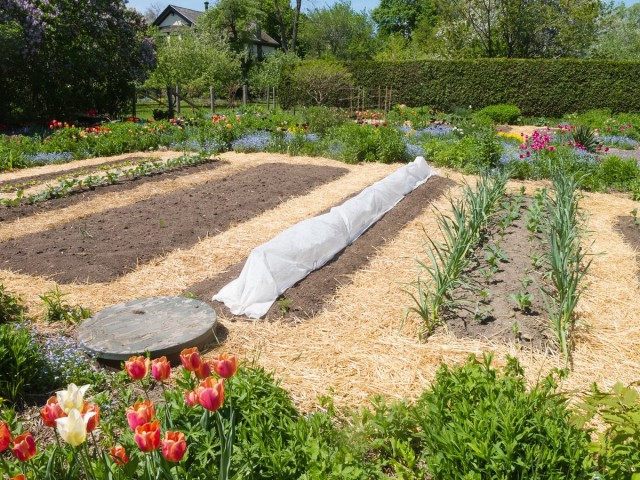
Cons of recessed beds
- The complexity of the arrangement, and in the version with sides you need to purchase material;
- If the surface of the bed is not even, then water can stagnate in the lowest place, so the bed is carefully leveled before planting or sowing;
- If the trench is not dug deep enough on heavy soils, water can stagnate during irrigation, so you need to dig a deep trench and be sure to make a drainage layer.
Dear readers! As you can see, various options for arranging beds in the country can differ significantly in terms of the principle of the device, the crops recommended for planting in such beds, as well as the regions of use.
Therefore, if someone says that high or recessed beds are “super”, then do not rush to knock down boxes or dig. Be sure to analyze the characteristics of your site and soil and find your best option to facilitate your work in the garden and achieve the highest yields.
Learn More
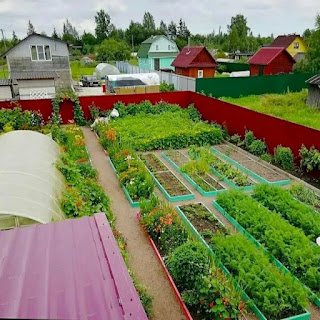




.jpeg)


0 Comments
Post a Comment